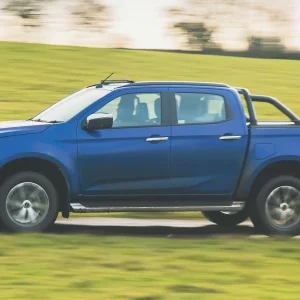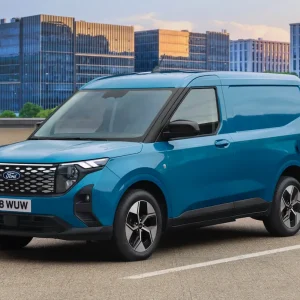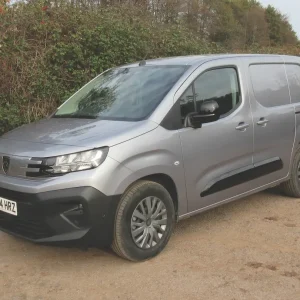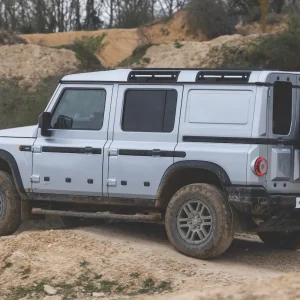Covid-19 and the impact of successive lockdowns have triggered an explosion in home shopping. With many high street retailers obliged to close, consumers have been buying online – and delivery companies have been working flat-out dropping off packages and collecting returned items.
Good news for the van market, and this looks set to continue as the economy gradually inches its way back to some semblance of normality. The reopening of non-essential stores is sure to prompt some purchasers to revert to more traditional ways of shopping, but online buying seems unlikely to disappear any time soon.
Home delivery is hard work, and light commercials engaged in it take a hammering. Clutches can soon wear out and manual gearboxes suffer too; so why not opt for an automatic?
Multi-speed auto boxes have been embraced widely by delivery fleets, and sales of 3.5t Mercedes-Benz Sprinters with automatic transmissions have benefitted as a consequence.
Other manufacturers are eager to grab a piece of the action, and Volkswagen Commercial Vehicles (VWCV) reckons it might be in with a shout.
Its current Crafter is available with an eight-speed, fully automatic gearbox– a transmission we’ve been eager to try, and the centrepiece of this month’s test – which can be specified in either the front or the rear-wheel drive variant. The alternative is the standard six-speed manual box.
Both transmissions are married to a 2.0-litre TDI diesel, the only power plant fitted to the vehicle. The horsepower choices are 102hp, 122hp, 140hp or 177hp, and the automatic box is on offer as an option with the two most powerful variants.
A battery-electric Crafter is in the pipeline but there is as yet no firm indication as to when it will appear in the UK. MAN markets a rebadged version of Crafter under the TGE banner and has already supplied 100 electric eTGEs to parcel giant DPD’s UK operation. Battery-electric technology will, of course, come to dominate home delivery in the longer term.
Grossing at from 3.0t–5.0t, the Crafter is produced in van, chassis cab and chassis double-cab guise. Van load cubes range from 9.3m3 to an echoing 18.4m3 – two different wheelbases and three different heights are listed – while gross payload capacities extend from 801kg to 2,560kg.
Customers can choose from Startline or Trendline specification levels, and upgrade with a Business Pack should they so wish.
Worthy of note is the 4MOTION four-wheel drive Crafter. The 4×4 system is fitted by VWCV itself rather than a converter.
We elected to sample a CR35 3.5t, front-wheel drive, medium-wheelbase (3640mm) van in Trendline trim with the auto box and 177hp to play with. So, how good is it?
Load bay
Entrance to the 10.7m3 cargo bay is through a sliding nearside door or twin rear doors that can be pushed through 270º and secured against the sides of the body.
Large yellow grab handles are positioned at both door apertures to make it easier for you to heave yourself aboard. Our test van was also fitted with an optional step integrated into the back bumper.
Ten floor-mounted load tie-down points are installed. Should anything break loose from its moorings, the hefty-looking full-height steel bulkhead should stop it dead in its tracks and prevent it from clobbering whoever is in the cab.
A tailored wooden cover protected our demonstrator’s cargo bed and the remainder of the load bay was timbered out, although there was no protection for the always vulnerable wheel boxes.
Interior and equipment
Climb into the Crafter’s roomy three-seater cab and you are immediately faced with its uninspiring dashboard.
Though by no means pretty, it is at least practical and reeks of quality. The materials used are top notch and the entire edifice is well put together.
Furthermore, it plays a key role in providing whoever is in the cab with a remarkable amount of storage space.
You will find three shelves, two cubbyholes on top and cup holders at each extremity with shelves next to them. Lower down you will see a big lockable glovebox with a narrow shelf above it, while other oddment stowage facilities include a shelf and two bins in both of the doors.
One of the bins in each door has a moulding that can grasp a 1.5-litre bottle of water.
Pull down the centre section of the middle seat’s back and it is immediately transformed into a handy desk with pen trays, two cup holders and an elasticated band to keep paperwork in place. Lift up the passenger seat cushions and you will discover space underneath that you can use to hide items – a smartphone for example – from casual thieves.
With some three-seater vans, being able to turn the centre seat into a desk is its sole advantage because it is too cramped for an occupant to use with comfort. However, for the Crafter this is not too much of a problem. There is plenty of shoulder room, and while legroom cannot be classed as generous it is better than in other three-seater cabs we have tested.
Look up and you will spy two more shelves and two further cubbyholes above the windscreen. Overhead storage forms part of the optional Business Pack, which also includes air conditioning, an anti-theft alarm with interior monitoring and towing protection, and front and rear parking sensors.
Given that our Crafter had opaque rear doors we cannot help but feel that rear sensors should be standard on this model rather than requiring an extra charge.
Both the driver’s seat and the steering wheel are height-adjustable, with the former offering lumbar adjustment as well. The wheel can be altered for reach, plays host to remote controls for the radio and was heated in our case, though this is an added extra.
Our demonstrator came with an optional (and easy to use and effective) Discover Media satnav system with an 8in touchscreen. The screen also controls the upgraded DAB+ radio and forms part of a Bluetooth-enabled package, with a USB point sitting on top of the dashboard. This is complemented by 12v power sockets.
The option also features App-Connect, which displays supported apps using interfaces such as Apple CarPlay on the aforementioned screen, and We Connect preparation. We Connect enables media streaming and access to real-time traffic information among other features.
Cruise control with a speed limiter, a driver’s airbag, electric windows and electrically adjustable and heated exterior mirrors are all provided. The mirrors have a separate lower wide-angle section.
Our Crafter was also equipped with air conditioning, another added option.
VWCV has made a major commitment to safety for many years and the Crafter is helping to uphold this praiseworthy tradition.
It comes with a comprehensive suite of safety packages that includes ABS, electronic stability programme, electronic brake assist and hill hold.
Automatic post-collision braking is part of the furniture as well. It instantly initiates braking if the driver is incapacitated by a collision in order to prevent any secondary impacts.
Present too is crosswind assist. It responds if a sudden strong gust of wind looks as though it is powerful enough to blow the Crafter out of its lane on the motorway and into an adjacent lane – and potentially into the path of oncoming vehicles.
The Crafter’s big safety plus, however, is a front assist emergency braking system. It operates in conjunction with city emergency braking and the package is standard on all models.
Front assist warns the driver if a front-end collision looks likely, jolts the brakes if the warning is not acted on, then ensures that maximum braking power is available instantly if the driver stops daydreaming and stamps hard on the brake pedal.
City emergency braking quickly slams on the brakes at up to 18mph on urban thoroughfares if the driver fails to see an obstruction and is on course to hit it.
Grab handles are mounted on each of the A-pillars so at least the passenger will have something to cling on to as the van judders to a halt.
Continuing on the safety side, the Crafter was equipped with an optional rear-view camera and Lights and Vision Pack A. This added option includes headlights that illuminate automatically when necessary and a rain sensor that triggers the windscreen wipers when required.
Disc brakes are installed all round. McPherson strut-type suspension is fitted at the front, while leaf springs help support the back. Our Crafter’s 16in steel wheels wore Continental ContiVan Contact 205/75 R16C tyres.
Electromechanical power-assisted steering offers a 13.6m wall-to-wall turning circle.
Powertrain
Power comes courtesy of a four-cylinder in-line 16-valve turbocharged engine equipped with common rail fuel injection and a diesel particulate filter. AdBlue held in an 18-litre reservoir helps ensure it meets the latest Euro 6 exhaust emission regulations.
Top power bites at 3,600pm. Maximum torque of 410Nm is delivered across a 1,500rpm to 2,000rpm plateau.
Driving
A slight hesitancy as the automatic Crafter pulled away from rest had us worried, but after that we had no cause for concern.
It accelerates briskly through the gears with no jerking or juddering as the transmission changes from one gear to the next, and a rapid kick-down means you can whizz past meandering cyclists without breaking a sweat.
The box gives you the ability to switch to manual – all you need to do is tap the shift lever to the right, but why would you? Doing so makes little discernible difference to the van’s low-speed performance, so you might as well leave it and let the automatic function get on with what it does best.
The Crafter handles well and always feels firmly planted on the highway. You can corner with confidence.
One issue is that there is a touch too much growling and grumbling from the engine at times and the ride could do with being a tad smoother.
It is acceptable, but cannot be classed as outstanding; there were times when we detected a bit of shimmying from the body. This was surprising given the Crafter’s otherwise outstanding build quality.
Solid construction and plenty of kit can of course impact on fuel usage and payload capacity, and the Crafter’s is not especially generous.
Volkswagen quotes a Worldwide Harmonised Light Vehicle Test Procedure (WLTP) combined fuel consumption figure of 28.2mpg. In our experience that is fairly accurate; the stop/start function goes some way towards keeping diesel usage down.
Operating
The Crafter is covered by a three-year/100,000-mile warranty, with roadside assistance included for the duration. A three-year paintwork warranty is provided too, along with a 12-year anti-perforation corrosion warranty.
Service intervals are set at two years/30,000 miles and should really be supplemented by interim safety checks.
Deep side rubbing strips should provide plenty of protection from minor bumps and scrapes, and can only be applauded given the price of the optional metallic paint finish.
Volkswagen Crafter CR35 Trendline MWB 2.0 TDI 177hp FWD 8spd auto
Price (ex VAT) £36,680
Price range (ex VAT) £27,220-£44,145
Gross payload 1,191kg
Load length 3,450m
Load width (min/max) 1,380mm/1,832mm
Load bay height 1,961mm
Load volume 10.7m3
Loading height 670mm
Rear door aperture 1,552mm x 1,840mm
Side door aperture 1,311mm x 1,822mm
Gross vehicle weight 3,500kg
Braked trailer towing weight 3,000kg
Residual value TBA
Cost per mile TBA
Engine size/power 1,968cc, 177hp @ 3,600rpm
Torque 410Nm @ 1,500-2,000rpm
Gearbox 8sp auto
Fuel economy 28.2 mpg (WLTP combined)
Fuel tank 75 litres
CO2 203g/km
Warranty 3yrs/100,000 miles
Service intervals 2yrs/30,000 miles
Insurance group 42A
Price as tested £40,935
Options
Business Pack £1,320
Body-coloured bumpers £60
Discover Media Navigation system £750
Heated and leather-trimmed steering wheel £285
Lights and Vision pack A £230
Rear bumper step £215
Rear view camera £235
Metallic paint £1,160
Rivals
Ford Transit
Price (ex VAT) £27,550-£44,045
Load volume 9.5-15.1m3
Gross payload 895-2,209kg
Engines 105hp, 130hp, 170hp, 185hp 2.0 diesel
Verdict: Despite pressure from Mercedes-Benz’s Sprinter, the Transit remains an established British icon although the van is no longer built here but in Ford’s plant in Turkey. For your money you get a well-designed cab, impressive engine, slick manual box and automatic boxes – a 10-speed on rear-wheel drive models – that are well worth investigating. It’s just a shame that the electric version is taking such a long time to arrive.
Mercedes-Benz Sprinter
Price (ex VAT) £27,345-£57,965
Load volume 7.8-17m3
Gross payload 731-2,529kg
Engines 150hp, 170hp 2.0 diesel, 143hp, 163hp 2.1 diesel, 190hp 3.0 diesel, 85kW electric
Verdict: Rock-solid build quality and the availability of automatic transmissions are among the key reasons why the Sprinter is so popular with home delivery fleets. What’s more, the emphasis on on-board safety helps businesses discharge their duty of care to employees. The electric Sprinter is starting to get itself noticed and marketplace trends should prompt sales to rise steadily.
Renault Master
Price (ex VAT) £28,400-£61,800
Load volume 8.0-17.0m3
Gross payload 848-1,990kg
Engines 135hp, 150hp, 180hp 2.3 diesel, 57kW electric
Verdict: While decent engines and plenty of payload capacity and cargo space are among the Master’s advantages, one of its biggest plus-points is the availability of an electric model. Renault is also working on equipping it with a fuel cell that will act as a range extender. Remember that Nissan’s NV400 and Vauxhall’s Movano share the same basic design and that the Master is marketed through Renault Trucks as well as Renault car and van dealerships.
The Final Verdict
Design 8/10 – No style icon, but a well-built, practical vehicle with a heavy accent on safety
Cabin 8/10 – Roomy and comfortable with plenty of storage space
Ride 7/10 – Acceptable but not outstanding, uneven surfaces are a challenge when unladen
Refinement 7/10 – Noise levels well under control aside from the odd growl from the engine
Load area 8/10 – Big rear door aperture and no shortage of load tie-down points
Handling/performance 8/10 – Well up to standard aside from some hesitancy when you pull away from rest
Engine/transmission 8/10 – Well matched, with smooth acceleration up through the gears
Standard equipment 7/10 – Reversing sensors are not fitted as standard, despite the stress on safety
Operating costs 7/10 – Comprehensive warranty package is welcome and reasonable fuel economy
What Van? subjective rating 8/10 – Without a doubt a convincing rival to Mercedes-Benz’s all-conquering Sprinter.
Overall Rating = 76/100





